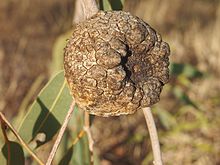| Bush coconut | |
|---|---|

| |
| Scientific classification | |
| Domain: | Eukaryota |
| Kingdom: | Animalia |
| Phylum: | Arthropoda |
| Class: | Insecta |
| Order: | Hemiptera |
| Suborder: | Sternorrhyncha |
| Family: | Eriococcidae |
| Genus: | Cystococcus Fuller, 1897 |
| Species[1] | |
| |
The bush coconut, or bloodwood apple, is an Australian bush tucker food. It is an insect gall with both plant and animal components: an adult female scale insect and her offspring (of genus Cystococcus) live in a gall induced on a bloodwood eucalypt tree (Corymbia). Bush coconuts can vary from golf ball to tennis ball size. They have a hard and lumpy outer layer. The inner layer is a white flesh that contains the female insect and her offspring. There are three known species of Cystococcus responsible for forming the bush coconut: Cystococcus pomiformis, Cystococcus echiniformis and Cystococcus campanidorsalis. C. pomiformis is the most common species. The bush coconut is found in Western Australia, the Northern Territory, Queensland and New South Wales.
The bush coconut is picked from the host tree and cracked open to allow the flesh and scale insects to be eaten. Both have a high protein content and are used as a food source by humans and other animals. The name 'bush coconut' is derived from the white flesh of the inner layer, which is similar in appearance to that of a coconut, and the taste of the flesh has been said to have a coconut flavour. The bush coconut has been depicted in Indigenous Australian dreaming and used as inspiration in their artwork.
- ^ "Cystococcus". Global Biodiversity Information Facility. Retrieved 10 January 2022.